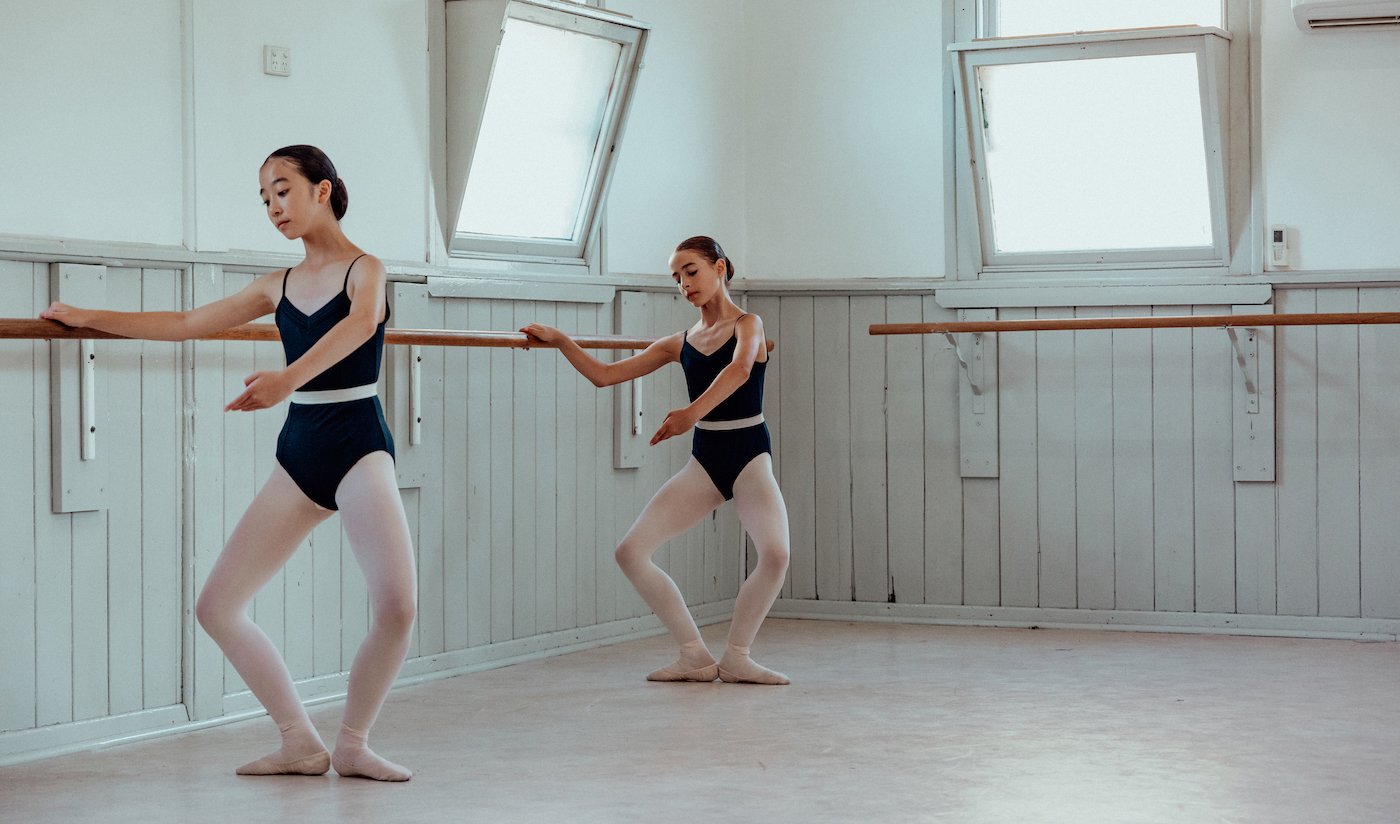Dance Advice | How to Get the Most out of Your Pliés
Allegra and Archie wear the Ruby Camisole and Audrey Skirt, and Conrad Leotard and Oakley Bike Short
Pliés are one of the most recognisable and fundamental ballet positions. Translating to ‘bend’ in French, pliés are defined as bending the knees in either a demi plié (half bend of the knees) or a grand plié (full bend of the knees). They can be performed in any of the five (some argue six if you include parallel) ballet positions. Pliés are one of the most important movements in ballet - they appear virtually everywhere. They start and end every jump, turn, and transition from one position to another. A correctly executed plié can be a significant contributing factor in the pursuit of a long, injury-free life of dancing. It’s one of the first movements you learn in ballet and one you’ll practice at the beginning of every class, no matter how advanced the level you attain. By making the most out of your pliés, you will build a solid ballet foundation that helps you gain even more movement from your dance.
When it comes to doing pliés there are several points that need to be taken into consideration. These aren’t designed to restrict movement. They are there to ensure that you will be getting the most out of your pliés by enhancing and accentuating your movement. Most of these will have been repeated time and time again by your dance teachers growing up but there’s no harm in a little refresh. The points below highlight the key points to be mindful of when doing your pliés, allowing you to be the best dancer you can be!
Plié exercises at the barre help to warm up and strengthen the muscles and joints of the feet, knees, hips and core. As a transitioning step, the plié plays a key role in moving from one step to the next both at the barre and in the centre. Pliés at the barre can also act as a place of calm and focus that one can use to mentally prepare for a performance or day ahead. They also give you the opportunity to get in tune with your body by focusing on the repetitive movement of your muscles.
Ruby wears the Ophelia Camisole and Melody Skirt in Lilac
Pliés should be controlled, continuous movements. They shouldn’t appear sudden or rigid and the timing of the descent and ascent should be equal. You should never sit at the bottom of a plié. Begin ascending as soon as you reach your lowest point and stay consistent with your timing. Use resistance as you bend on the way down to the base of the plié and continue to use resistance as you recover to straight legs. Think of actively working and engaging the legs, not simply bending the legs and straightening. Sometimes using the analogy of bending through honey can help with the notion of adding resistance as it is thick and sticky, making it harder to bend and stretch.
You also want to ensure that your knees are over your toes when you bend, with your weight around the second and third toes. Don’t let your weight roll over your big toe as this can lead to your feet rolling inwards (pronation) which can lead to strain on the tendons and ligaments on the inside of the foot. Weight should be centred evenly between the feet and the insteps should be lifted. Avoid your toes gripping the floor and aim to keep the ankle still and relaxed. You don’t want to have any tension at the front of the ankle as it can lead to inflammation and strain of the anterior tendon, resulting in injury. Relax your ankles and feet so that your toes are spread out for maximum balance.
Pliés encompass more than just the ankles and feet. Don’t forget to maximise the rotation of your legs to enhance your turnout. Think of rotating your inner thighs from the tops of your legs to create a turned out position. If you aren’t turning out from the tops of your legs, your knees will have a difficult time bending over your toes, causing your knees to roll forwards which can again cause injury as a result of repetitive strain. When the tops of your inner thighs are engaged, the more power and control you’ll have over your plié.
Students from En Pointe School of Ballet perform a demi plié at the barre
Keeping your back straight and being conscious of leaning too far forward or back will also improve your pliés. It’s great to use your upper body and head for épaulement to highlight the movement but avoid moving the entire top half of your body forwards or backwards. This will throw you off your centre and alter the shape of the plié. Having a strong core will also help you keep your posture and alignment correct in pliés, allowing you to feel centred and grounded.
We also need to be mindful of when you lift our heels off the ground in a grand plié. Ideally we want the achilles tendon to reach maximum stretch before we lift the heels off the floor. Don’t let your heels lift until the last possible second. When rising up from the grand plié, touch the heels down as soon as possible before you completely stretch your legs. It can be challenging initially but will gradually ease with practice. Tight calves can reduce the depth of your plié so ensure you stretch before and after class to keep them as flexible as you can.
Imagery often helps with a dancers mind-body connection and improvement of technique. Like we spoke of the honey before, having a visual reference to imagine can improve the execution of a step or sequence of steps. Eric Franklin, author of the book ‘Dynamic Alignment Through Imagery’, suggests you think of a flying carpet during your next plié. “Imagine the pelvic floor to be a flying carpet that lifts and supports the pelvis and torso. As you move, the flying carpet supports the pelvis and frees the legs”. Imagining the pelvic floor floating will help maintain a neutral spine and engage the correct muscles for turnout and alignment support.
A quintessential ballet step, pliés add depth, dynamics, and breath to your movement. Supporting you throughout your dance journey, you can always rely on pliés to ground you, bring you back to your centre, and refine your dance skills. A transition step itself, pliés will also be with you as you transition from a a baby ballerina to a professional dancer.
Maya and Ruby wear the Karen Lace Camisole and Hannah Lace Leotard paired with the Melody Skirt
Article by Sheree Ronai-Horvath
Photography by Elly Ford








